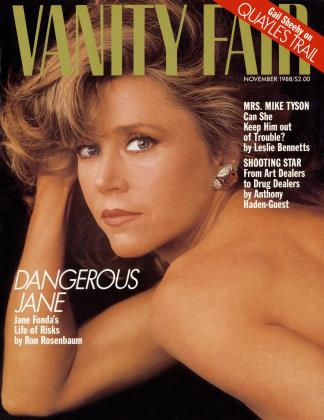Sign In to Your Account
Subscribers have complete access to the archive.
Sign In Not a Subscriber?Join NowEditor's Letter
Life on the Edge
Jane Fonda poses with that Hanoi anti-aircraft gun and sixteen years later summons up the strength to apologize. Robin Givens, the preppy honors student who shows up at college with a trunkload of Ralph Lauren skirts, takes on the world heavyweight champion Mike Tyson and sets out to subdue him. Jean-Michel Basquiat leaves his middle-class Haitian family in Brooklyn to become a rebel artist in Manhattan and dies young, maybe because he believes artists should.
This is life on the edge, lived by three very different incendiary personalities in the only way they could. They are all featured in profiles in this month's Vanity Fair, linked by this common theme but diverse in their use of risk for selfexpression. Ron Rosenbaum writes that while Fonda "denies getting pleasure from that scary loss of control, she concedes that she repeatedly seeks it out." On page 142 Rosenbaum traces the thread of panicky courage that not only led Fonda into political activism but was central to many of her best roles. In Klute, Coming Home, Julia, The China Syndrome, Nine to Five, and The Morning After she portrayed women fighting panic to be braver than they felt. Some may think she's doing that again by posing at fifty-one for photographs that recall the spumed glamour of her Barbarella days—some risk. Danger has never suited Fonda better. Danger is new to Robin Givens, but she is learning to cope with it as her husband of nine months, Mike Tyson, ricochets from one frontpage crisis to another. In the portrait by Leslie Bennetts, Vanity Fair's newest contributing editor, on page 154, Givens is revealed as a more engaging and feisty figure than her media rap as the Yoko Ono of the boxing ring.
Jean-Michel Basquiat, like Fonda, regarded danger as the artist's creed, but he went over the edge. He died this year at age twenty-seven, a heroin addict. Anthony Haden-Guest's story on page 180 is more than the chronicle of the burnout of an artist; it sets Basquiat chillingly in the context of the hype and cynicism of the contemporary art market.
And on page 148 Gail Sheehy contributes the last of her pre-election profiles. She has been talking to people in Huntington, Indiana, in Wickenburg, Arizona, and in Washington, D.C., on the trail of "just Danny" Quayle. She concludes that the only risk taken here is America's.
Editor in chief
 View Full Issue
View Full Issue












Subscribers have complete access to the archive.
Sign In Not a Subscriber?Join Now